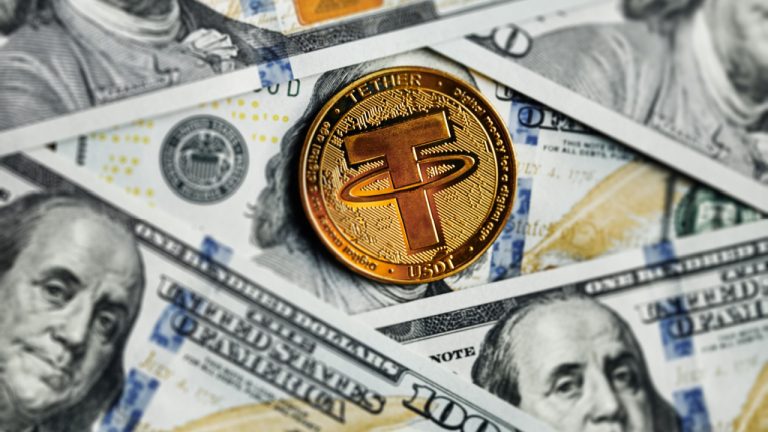
Arthur Hayes Predicts Banks Will Replace Tether and Other Stablecoin Companies
Arthur Hayes, the former CEO of Bitmex and current CIO of Malestrom, a crypto-focused early-stage investment fund, has raised concerns about the future of Tether and other stablecoin companies. According to Hayes, big banks like JPMorgan will eventually cannibalize Tether's business model and dominate the stablecoin market.
During an interview on Laura Shin's Unchained podcast, Hayes explained that Tether's success in the crypto market is primarily due to the absence of a similar product offered by the U.S. banking system. However, he believes that this will change once traditional banks are granted permission to issue fiat-backed stablecoins.
The Flaw in Tether's Business Model
Tether's business model revolves around taking dollars, investing them in treasuries, and earning interest from the spread. As a result, the owners of Tether generate billions of dollars in free cash flow annually. Hayes acknowledges the success of Tether in this regard, but he also points out a crucial flaw.
"The people who own Tether make something like $4 or $5 billion in free cash flow every year. It's basically an interest rate: they basically take dollars, stuff it in a bank account, and then they go buy treasury bills and they earn the spread."
Hayes argues that centralized stablecoins like Tether rely heavily on banks to clear and custody their funds. He criticizes bank managers for providing these services to stablecoin companies while failing to achieve the same performance with their own stablecoins. In his own words, these bank managers are "f***ing morons."
The Inevitable Takeover by Banks
Hayes predicts that the dominance of stablecoin companies like Tether will come to an end once traditional banks are allowed to issue their own stablecoins. He believes that banks like JPMorgan will quickly replace Tether and other stablecoin companies, leveraging their existing infrastructure and reputation.
According to Hayes, the current stablecoin companies have no defensible business model because they rely on banks to custody their funds and enable them to trade. Once banks enter the stablecoin market, they will offer the same interest rates and services, rendering the existing stablecoin companies obsolete.
Tether, with a market cap of $91.5 billion and $4 billion in excess reserves, is currently one of the largest stablecoin companies. However, its future may be uncertain if Hayes' predictions come true.
What do you think about Arthur Hayes' perspective on the future of Tether and centralized stablecoins? Share your thoughts in the comments section below.
Frequently Asked Questions
What are the benefits to having a gold IRA
You can save money on retirement by putting your money into an Individual Retirement Account. It's tax-deferred until you withdraw it. You control how much you take each year. There are many types to choose from when it comes to IRAs. Some are better suited to college savings. Others are intended for investors seeking higher returns. Roth IRAs let individuals contribute after age 591/2 and pay tax on any earnings at retirement. The earnings earned after they withdraw the funds aren't subject to any tax. This account may be worth considering if you are looking to retire earlier.
Because it allows you money to be invested in multiple asset classes, a ‘gold IRA' is similar to any other IRAs. Unlike a regular IRA, you don't have to worry about paying taxes on your gains while you wait to access them. People who prefer to save their money and invest it instead of spending it are well-suited for gold IRAs.
You can also enjoy automatic withdrawals, which is another benefit of owning your gold through an IRA. It means that you don’t have to remember to make deposits every month. Direct debits could be set up to ensure you don't miss a single payment.
Finally, gold is one of the safest investment choices available today. Because it isn’t tied to any specific country, gold’s value tends to stay stable. Even in times of economic turmoil, gold prices tend not to fluctuate. As a result, it's often considered a good choice when protecting your savings from inflation.
How much of your portfolio should be in precious metals?
To answer this question we need to first define precious metals. Precious Metals are elements that have a very high relative value to other commodities. This makes them very valuable in terms of trading and investment. The most traded precious metal is gold.
There are also many other precious metals such as platinum and silver. The price for gold is subject to fluctuations, but stays relatively stable in times of economic turmoil. It also remains relatively unaffected by inflation and deflation.
All precious metals prices tend to rise with the overall market. That said, they do not always move in lockstep with each other. If the economy is struggling, the gold price tends to rise, while the prices for other precious metals tends to fall. This is because investors expect lower interest rates, making bonds less attractive investments.
The opposite effect happens when the economy is strong. Investors are more inclined to invest in safe assets, such as Treasury Bonds, and they will not demand precious metals. They are more rare, so they become more expensive and less valuable.
Therefore, to maximize profits from investing in precious metals, you must diversify across multiple precious metals. You should also diversify because precious metal prices can fluctuate and it is better to invest in multiple types of precious metals than in one.
Is it a good retirement strategy to buy gold?
Although it may not look appealing at first, buying gold for investment is worth considering when you consider the global average gold consumption per year.
Physical bullion bar is the best way to invest in precious metals. You can also invest in gold in other ways. It is best to research all options and make informed decisions based on your goals.
If you don't want to keep your wealth safe, buying shares in companies that extract gold and mining equipment could be a better choice. Owning gold stocks should work well if you need cash flow from your investment.
You can also put your money in exchange traded funds (ETFs). These funds allow you to be exposed to the price and value of gold by holding gold related securities. These ETFs often include stocks of gold miners, precious metals refiners, and commodity trading companies.
Statistics
- This is a 15% margin that has shown no stable direction of growth but fluctuates seemingly at random. (smartasset.com)
- You can only purchase gold bars at least 99.5% purity. (forbes.com)
- Instead, the economy improved, stocks rebounded, and gold plunged, losing 28 percent of its value in 2013. (aarp.org)
- (Basically, if your GDP grows by 2%, you need miners to dig 2% more gold out of the ground every year to keep prices steady.) (smartasset.com)
- Contribution limits$6,000 (49 and under) $7,000 (50 and up)$6,000 (49 and under) $7,000 (50 and up)$58,000 or 25% of your annual compensation (whichever is smaller) (lendedu.com)
External Links
investopedia.com
cftc.gov
- Fraud Advisory: Precious Metals Fraud
—————————————————————————————————————————————————————————————-
Based on [POSTTITLE]
by [POSTAUTHOR]
Related posts:
 Howard Lutnick, Cantor Fitzgerald CEO, Confirms Business Relationship with Tether
Howard Lutnick, Cantor Fitzgerald CEO, Confirms Business Relationship with Tether
 JPMorgan Warns of Increased Risk for Crypto Market Due to Tether’s Lack of Regulatory Compliance and Transparency
JPMorgan Warns of Increased Risk for Crypto Market Due to Tether’s Lack of Regulatory Compliance and Transparency
 2023: Comparing cryptocurrency. The Coins To Be aware of
2023: Comparing cryptocurrency. The Coins To Be aware of
 Former Bitmex Chief Predicts 30% BTC Correction — Warns Spot Bitcoin ETFs Could Make It Worse
Former Bitmex Chief Predicts 30% BTC Correction — Warns Spot Bitcoin ETFs Could Make It Worse













